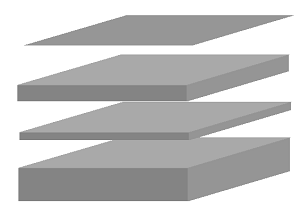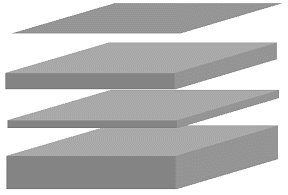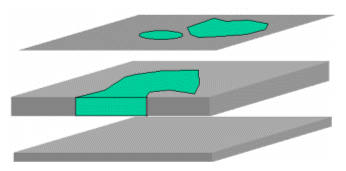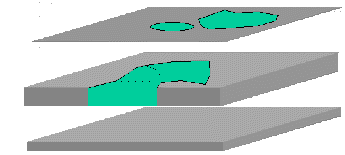
SADA 4 permits users to create layering schemes, name them, and recall them at any time. Within these layering schemes, users can specify multiple layers of regular or varying thicknesses. Unlike Version 3, these layering schemes now are used freely in both the data analysis and geospatial modeling realms, since the revised spatial models can now handle irregular depth layers.


Polygons have also undergone a similar change. As before, polygons can be created and named. However, now polygon designs (sets of polygons) are associated with one or more layers within a layering scheme. Furthermore, a polygon design can be used in multiple layering schemes. It can be helpful to think of polygons as being a form of a GIS layer that can be shown under a number of circumstances. It is important to understand, however, that if the polygon design is edited, the change will occur throughout every layer design that uses that polygon design. Polygon designs are always 2d in the sense that they only apply to one layer at a time. In other words, they don’t "cut through" a set of layers unless requested by the user.


After a layering design has been created, a polygon scheme can be associated with each layer, and layers can be turned on and off. If a layer is turned off, then anything in that layer is treated as "unincluded" in exactly the same way that a data point that falls outside of a polygon is unincluded. In the case of geospatial analysis (kriging, correlation modeling,etc), however, those data are still used unless the box next to Use only included data during interpolation is checked on the Parameters window for the Step Set up the site.
Fixed or Locked Designs
Further advances in SADA’s capabilities now include geobayesian models, result galleries, and MARSSIM sample designs. These three types of analysis affect both layer and polygon designs. The geobayesian models are quite advanced and may be used by only a small cross section of SADA modelers. Similarly the MARSSIM sample designs are intended for a targeted audience. As a result, many of the effects of these models on layer designs will never be encountered by most users. Most users, however, will need to understand how layer designs are affected by the Results Gallery.
All three of these features rely on a fixed and unchanging layering design. Therefore, at the time they are created, a copy of the chosen layer design becomes fixed or locked. So for example, if a current layer design is named MyLayerDesign, SADA will copy this layer design and name it something like Results Gallery 120918233423. (The numbers at the end of the title ensure a unique name for each copy event.) MyLayerDesign remains unchanged and can still be edited by the user. Results Gallery 120918233423, however, is fixed and cannot be changed. This occurs for both geobayesian and results gallery actions.
Similarly, if a MARSSIM sample design is created, the current layer design is copied and renamed. Typically, the layer will receive a name like MARSSIM 12108323882. Again, the numbers at the end of the name ensure a unique name during the copy event. MARSSIM 12108323882 is locked by the MARSSIM design. When a layer is locked, no aspect of the layer can be changed, including the polygons. Since any polygons associated with the layering design are locked, they cannot be edited or removed from the design. See polygons.
Fixing and locking designs should have little or no affect on normal use of the code, since the original layer remains unfixed or unlocked and can continue to be used normally. SADA does add each of these fixed or locked designs to the list of available layering schemes. As a result, they could be used for other purposes. For example, they could be used in a geospatial model, or even in another MARSSIM design. Since the layering schemes are locked or fixed and are un-editable, they are limited in use. The real intention in keeping them is to support the three types of features described above. If a user wishes to recall a results gallery, the corresponding fixed layer design is retrieved.
For specific instructions on using these options in the Parameters window, see Vertical Layers and Polygons.